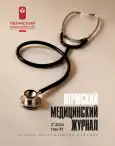The options for prognosis of the outcome of ischemic stroke in young patients
- Authors: Gusev V.V.1,2,3, Lvova O.А.1,2, Kovtun O.P.1, Shamalov N.А.4, Sergeev A.P.2,5, Sergeeva M.V.5, Medvedeva D.A.6
-
Affiliations:
- Ural State Medical University
- Ural Federal University Named After the First President of Russia B.N. Yeltsin
- Central City Clinical Hospital № 23
- Institute of Cerebrovascular Pathology and Stroke “Federal Brain and Neurotechnology Center”
- Institute of Industrial Ecology of the Russian Academy of Sciences, Ural Department
- Children`s City Clinical Hospital № 9
- Issue: Vol 41, No 2 (2024)
- Pages: 87-95
- Section: Methods of diagnosis and technologies
- URL: https://journals.rcsi.science/PMJ/article/view/257650
- DOI: https://doi.org/10.17816/pmj41287-95
- ID: 257650
Cite item
Abstract
Objective. To develop criteria for prognosis of the outcome of ischemic stroke, taking into account age, dynamics of state assessment, the Rankin and NIHSS scales readings and the fact of disability in the long-term period. The universal reliable criteria, that allow to predict the outcome of ischemic stroke, have not been developed yet.
Material and methods. The study group consisted of 246 patients with ischemic stroke aged 18 to 44 who were observed from 2008 to 2021.
Results. It is impossible to predict disability in a long-term period of ischemic stroke reliably. Predicting the outcome of ischemic stroke using the Rankin and NIHSS scales is significant in the acute period and allows to predict the dynamics of recovery in mild and moderate cases.
Conclusion. The predictive value of the integrative indicators of the patient's condition, assessed by the Rankin and NIHSS scales, has been established.
Full Text
##article.viewOnOriginalSite##About the authors
V. V. Gusev
Ural State Medical University; Ural Federal University Named After the First President of Russia B.N. Yeltsin; Central City Clinical Hospital № 23
Email: gusev_vadim@inbox.ru
ORCID iD: 0000-0003-2232-7074
SPIN-code: 9469-8054
Candidate of Medical Sciences, Associate Professor
Russian Federation, Yekaterinburg; Yekaterinburg; YekaterinburgO. А. Lvova
Ural State Medical University; Ural Federal University Named After the First President of Russia B.N. Yeltsin
Email: olvova@bk.ru
ORCID iD: 0000-0002-2280-3096
MD, PhD, Associate Professor
Russian Federation, Yekaterinburg; YekaterinburgO. P. Kovtun
Ural State Medical University
Email: olgakovtun@inbox.ru
ORCID iD: 0000-0002-5250-7351
MD, PhD, Professor, Academician of the Russian Academy of Sciences, Rector
Russian Federation, YekaterinburgN. А. Shamalov
Institute of Cerebrovascular Pathology and Stroke “Federal Brain and Neurotechnology Center”
Email: shamalovn@gmail.com
ORCID iD: 0000-0001-6250-0762
MD, PhD, Professor
Russian Federation, MoscowA. P. Sergeev
Ural Federal University Named After the First President of Russia B.N. Yeltsin; Institute of Industrial Ecology of the Russian Academy of Sciences, Ural Department
Email: alexanderpsergeev@gmail.com
ORCID iD: 0000-0001-7883-6017
Candidate of Physical-Mathematical Sciences, Associate Professor
Russian Federation, Yekaterinburg; YekaterinburgM. V. Sergeeva
Institute of Industrial Ecology of the Russian Academy of Sciences, Ural Department
Email: alexanderpsergeev@gmail.com
ORCID iD: 0000-0002-9782-5185
Researcher
Russian Federation, YekaterinburgD. A. Medvedeva
Children`s City Clinical Hospital № 9
Author for correspondence.
Email: dmedstud@mail.ru
ORCID iD: 0000-0001-8613-5982
Physician
Russian Federation, YekaterinburgReferences
- Wafa H.A., Wolfe C.D.A., Emmett E. et al. Burden of Stroke in Europe: Thirty-Year Projections of Incidence, Prevalence, Deaths, and Disability-Adjusted Life Years. Stroke. 2020; 51 (8): 2418–27. doi: 10.1161/STROKEAHA. 120.029606. Epub 2020 Jul 10.
- Lindsay M.P., Norrving B., Sacco R.L. et al. World Stroke Organization (WSO): Global Stroke Fact Sheet 2019. Int J Stroke. 2019; 14 (8): 806–17. doi: 10.1177/1747493019881353
- Самородская И.В., Зайратьянц О.В., Перхов В.И. и др. Динамика показателей смертности населения от острого нарушения мозгового кровообращения в России и США за 15-летний период. Архив патологии 2018; 80 (2): 30–7. doi: 10.17116/patol 201880230-37 / Samorodskaia I.V., Zairat’yants O.V., Perkhov V.I. et al. Trends in stroke mortality rates in Russia and the USA over a 15-year period. Arkhiv Patologii 2018; 80 (2): 30–7. doi: 10.17116/patol201880230-37 (in Russian).
- Калашникова Л.А., Добрынина Л.А. Ишемический инсульт в молодом возрасте. Журнал неврологии и психиатрии им. С.С. Корсакова. Спецвыпуски. 2017; 117 (8): 3–12. doi: 10.17116/jnevro2017117823-12 / Kalashnikova L.A., Dobrynina L.A. Ishemicheskij insul't v molodom vozraste. ZHurnal nevrologii i psihiatrii im. S.S. Korsakova. Specvypuski. 2017; 117 (8): 3-12 (in Russian).
- Cramer S.C. Recovery After Stroke. Continuum (Minneap Minn). 2020; 26 (2): 415–434. doi: 10.1212/CON.0000000000000838. PMID: 32224759.
- Hussain A., Lee M., Rana J., Virani S.S. Epidemiology and risk factors for stroke in young individuals: implications for prevention. Curr Opin Cardiol. 2021 1; 36 (5): 565–571. doi: 10.1097/HCO.0000000000000894. PMID: 34397463.
- Cramer S.C. Recovery After Stroke. Continuum (Minneap Minn). 2020; 26 (2): 415–434. doi: 10.1212/CON.0000000000000838. PMID: 32224759
- Aigner A., Grittner U., Rolfs A., Norrving B., Siegerink B., Busch M.A. Contribution of established stroke risk factors to the burden of stroke in young adults. Stroke 2017; 48: 1744–1751.
- Li L., Yiin G.S., Geraghty O.C., Schulz U.G., Kuker W., Mehta Z., Rothwell P.M. Oxford Vascular Study. Incidence, outcome, risk factors, and long-term prognosis of cryptogenic transient ischaemic attack and ischaemic stroke: a population-based study. Lancet Neurol. 2015; 14 (9): 903–913. doi: 10.1016/S1474-4422(15) 00132-5. Epub 2015 Jul 27. PMID: 26227434; PMCID: PMC5714616.[
Supplementary files







